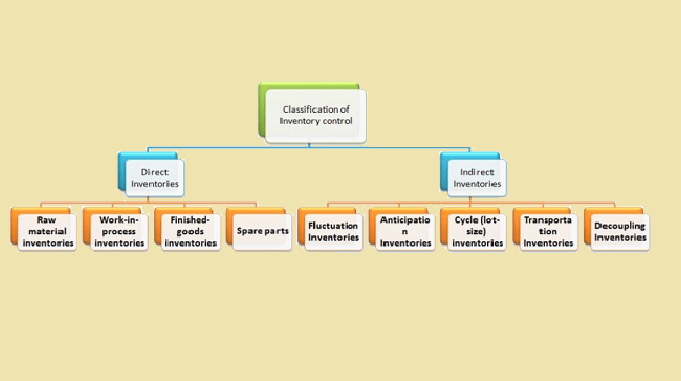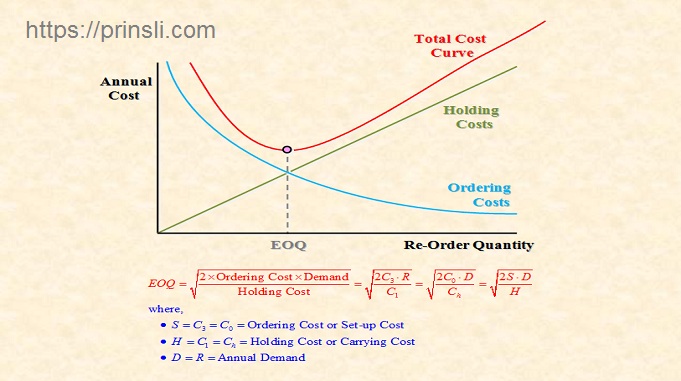
Classification of Inventory control:
The term inventory may be classified into two main categories.
1. Direct Inventories –
The items which play a direct role in the manufacture and become an integral part of finished goods are included in the category of direct inventories. These may be further classified into four main groups:
(a) Raw material inventories are provided:
(i) for economical bulk purchasing,
(ii) to enable production rate changes
(iii) to provide a production buffer against delays in transportation,
(iv) for seasonal fluctuations.
(b) Work-in-process inventories are provided:
(i) to enable economical lot production,
(ii) to cater to the variety of products
(iii) for replacement of wastages,
(iv) to maintain uniform production even if the number of sales may vary.
(c) Finished-goods inventories are provided:
(i) for maintaining off-self delivery,
(ii) to allow stabilization of the production level
(iii) for sales promotion.
(d) Spare parts.
2. Indirect Inventories –
Indirect inventories include those items, which are necessarily required for manufacturing but do not become the component of finished production, like oil, grease, lubricants, petrol, office-material maintenance material, etc.
Types of Inventory Models: Basically, there are five types of inventory models:
(a) Fluctuation Inventories:
These have to be carried out because sales and production times cannot be predicted accurately. In real-life problems, there are fluctuations in the demand and lead times that affect the production of items. Such types of reserve stocks or safety stocks are called fluctuation inventories.
(b) Anticipation Inventories:
These are built up in advance for the season of large sales, a promotion programme or a plant shutdown period. In fact, anticipation inventories store the men and machine hours for future requirements.
(c) Cycle (lot-size) inventories:
In practical situations, it seldom happens that the rate of consumption is the same as the rate of production or purchasing. So the items are procured in larger quantities than they are required. This results in cycle (or lot-size) inventories.
(d) Transportation Inventories:
Such inventories exist because the materials are required to move from one place to another. When the transportation time is long, the items under transport cannot be served to customers. These inventories exist solely because of transportation time.
(e) Decoupling Inventories:
Such inventories are needed for meeting out the demands during the decoupling period of manufacturing or purchasing.
Classification of Inventory control in Hindi:
The term inventory may be classified into two main categories.
1. Direct Inventories –
वे वस्तुएँ जो निर्माण में प्रत्यक्ष भूमिका निभाती हैं और तैयार माल का अभिन्न अंग बन जाती हैं, उन्हें प्रत्यक्ष सूची (Direct Inventories) की श्रेणी में शामिल किया जाता है। इन्हें आगे चार मुख्य समूहों में वर्गीकृत किया जा सकता है:
(a) कच्चे माल की सूची प्रदान की जाती है:
(i) किफायती थोक खरीद के लिए,
(ii) उत्पादन दर परिवर्तन को सक्षम करने के लिए
(iii) परिवहन में देरी के खिलाफ उत्पादन बफर प्रदान करना,
(iv) मौसमी उतार-चढ़ाव के लिए।
(b) कार्य-में-प्रगति सूची प्रदान की जाती है:
(i) किफायती लॉट उत्पादन को सक्षम करने के लिए,
(ii) उत्पादों की विविधता को पूरा करने के लिए
(iii) अपव्यय के प्रतिस्थापन के लिए,
(iv) एक समान उत्पादन बनाए रखने के लिए भले ही बिक्री की मात्रा भिन्न हो।
(c) तैयार माल की सूची प्रदान की जाती है:
(i) ऑफ-सेल्फ डिलीवरी को बनाए रखने के लिए,
(ii) उत्पादन स्तर के स्थिरीकरण की अनुमति देने के लिए
(iii) बिक्री संवर्धन के लिए।
(d) स्पेयर पार्ट्स।
2. Indirect Inventories –
अप्रत्यक्ष सूची (Indirect Inventories) में वे वस्तुएं शामिल हैं, जो निर्माण के लिए आवश्यक हैं, लेकिन तैयार उत्पादन के घटक नहीं बनते हैं, जैसे: तेल, ग्रीस, स्नेहक, पेट्रोल, और कार्यालय-सामग्री रखरखाव सामग्री, आदि।
इन्वेंट्री मॉडल के प्रकार: मूल रूप से, इन्वेंट्री मॉडल पांच प्रकार के होते हैं:
(a) उतार-चढ़ाव इन्वेंट्री:
इन्हें ले जाना होगा क्योंकि बिक्री और उत्पादन के समय का सटीक अनुमान नहीं लगाया जा सकता है। वास्तविक जीवन की समस्याओं में, मांग और लीड-टाइम में उतार-चढ़ाव होते हैं जो वस्तुओं के उत्पादन को प्रभावित करते हैं। इस प्रकार के आरक्षित स्टॉक या सुरक्षा स्टॉक को उतार-चढ़ाव सूची कहा जाता है।
(b) पूर्वानुमान इन्वेंट्री:
ये बड़ी बिक्री के मौसम, एक प्रचार कार्यक्रम या संयंत्र के बंद होने की अवधि के लिए अग्रिम रूप से बनाए गए हैं। वास्तव में, प्रत्याशा सूची भविष्य की आवश्यकताओं के लिए पुरुषों और मशीन के घंटों को संग्रहीत करती है।
(c) चक्र (लॉट-साइज) इन्वेंट्री:
व्यावहारिक स्थितियों में, ऐसा विरले ही होता है कि उपभोग की दर उत्पादन या क्रय की दर के समान हो। इसलिए वस्तुओं की खरीद आवश्यकता से अधिक मात्रा में की जाती है। इसका परिणाम चक्र (या लॉट-साइज़) इन्वेंट्री में होता है।
(d) परिवहन इन्वेंट्री:
इस तरह की सूची मौजूद है क्योंकि सामग्री को एक स्थान से दूसरे स्थान पर ले जाने की आवश्यकता होती है। जब परिवहन का समय लंबा होता है, तो परिवहन के तहत आने वाली वस्तुओं को ग्राहकों को नहीं परोसा जा सकता है। ये माल केवल परिवहन समय के कारण मौजूद हैं।
(e) डिकूपिंग इन्वेंट्री:
निर्माण या खरीद के दौरान मांगों को पूरा करने के लिए ऐसी सूची की आवश्यकता होती है। इस इन्वेंट्री में एक निर्माण प्रक्रिया के भीतर इन्वेंट्री को अलग करना शामिल है, जिससे एक निर्माण प्रक्रिया के एक चरण से जुड़ी इन्वेंट्री, प्रक्रिया के अन्य हिस्सों को धीमा न करे। सरल शब्दों में, डिकूपिंग इन्वेंट्री एक प्रकार का सुरक्षा स्टॉक है।
(Source – Various books of college library)
Copyrighted Material © 2019 - 2024 Prinsli.com - All rights reserved
All content on this website is copyrighted. It is prohibited to copy, publish or distribute the content and images of this website through any website, book, newspaper, software, videos, YouTube Channel or any other medium without written permission. You are not authorized to alter, obscure or remove any proprietary information, copyright or logo from this Website in any way. If any of these rules are violated, it will be strongly protested and legal action will be taken.






Be the first to comment